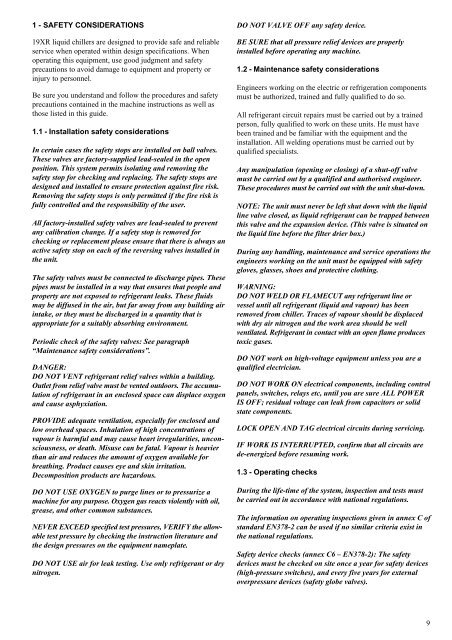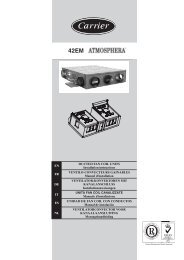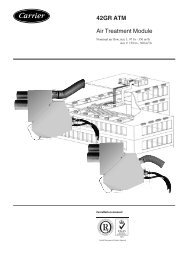19XR (PIC II) Hermetic Centrifugal Liquid Chillers 50 Hz - Carrier
19XR (PIC II) Hermetic Centrifugal Liquid Chillers 50 Hz - Carrier
19XR (PIC II) Hermetic Centrifugal Liquid Chillers 50 Hz - Carrier
You also want an ePaper? Increase the reach of your titles
YUMPU automatically turns print PDFs into web optimized ePapers that Google loves.
1 - SAFETY CONSIDERATIONS<br />
<strong>19XR</strong> liquid chillers are designed to provide safe and reliable<br />
service when operated within design specifications. When<br />
operating this equipment, use good judgment and safety<br />
precautions to avoid damage to equipment and property or<br />
injury to personnel.<br />
Be sure you understand and follow the procedures and safety<br />
precautions contained in the machine instructions as well as<br />
those listed in this guide.<br />
1.1 - Installation safety considerations<br />
In certain cases the safety stops are installed on ball valves.<br />
These valves are factory-supplied lead-sealed in the open<br />
position. This system permits isolating and removing the<br />
safety stop for checking and replacing. The safety stops are<br />
designed and installed to ensure protection against fire risk.<br />
Removing the safety stops is only permitted if the fire risk is<br />
fully controlled and the responsibility of the user.<br />
All factory-installed safety valves are lead-sealed to prevent<br />
any calibration change. If a safety stop is removed for<br />
checking or replacement please ensure that there is always an<br />
active safety stop on each of the reversing valves installed in<br />
the unit.<br />
The safety valves must be connected to discharge pipes. These<br />
pipes must be installed in a way that ensures that people and<br />
property are not exposed to refrigerant leaks. These fluids<br />
may be diffused in the air, but far away from any building air<br />
intake, or they must be discharged in a quantity that is<br />
appropriate for a suitably absorbing environment.<br />
Periodic check of the safety valves: See paragraph<br />
“Maintenance safety considerations”.<br />
DANGER:<br />
DO NOT VENT refrigerant relief valves within a building.<br />
Outlet from relief valve must be vented outdoors. The accumulation<br />
of refrigerant in an enclosed space can displace oxygen<br />
and cause asphyxiation.<br />
PROVIDE adequate ventilation, especially for enclosed and<br />
low overhead spaces. Inhalation of high concentrations of<br />
vapour is harmful and may cause heart irregularities, unconsciousness,<br />
or death. Misuse can be fatal. Vapour is heavier<br />
than air and reduces the amount of oxygen available for<br />
breathing. Product causes eye and skin irritation.<br />
Decomposition products are hazardous.<br />
DO NOT USE OXYGEN to purge lines or to pressurize a<br />
machine for any purpose. Oxygen gas reacts violently with oil,<br />
grease, and other common substances.<br />
NEVER EXCEED specified test pressures, VERIFY the allowable<br />
test pressure by checking the instruction literature and<br />
the design pressures on the equipment nameplate.<br />
DO NOT USE air for leak testing. Use only refrigerant or dry<br />
nitrogen.<br />
DO NOT VALVE OFF any safety device.<br />
BE SURE that all pressure relief devices are properly<br />
installed before operating any machine.<br />
1.2 - Maintenance safety considerations<br />
Engineers working on the electric or refrigeration components<br />
must be authorized, trained and fully qualified to do so.<br />
All refrigerant circuit repairs must be carried out by a trained<br />
person, fully qualified to work on these units. He must have<br />
been trained and be familiar with the equipment and the<br />
installation. All welding operations must be carried out by<br />
qualified specialists.<br />
Any manipulation (opening or closing) of a shut-off valve<br />
must be carried out by a qualified and authorised engineer.<br />
These procedures must be carried out with the unit shut-down.<br />
NOTE: The unit must never be left shut down with the liquid<br />
line valve closed, as liquid refrigerant can be trapped between<br />
this valve and the expansion device. (This valve is situated on<br />
the liquid line before the filter drier box.)<br />
During any handling, maintenance and service operations the<br />
engineers working on the unit must be equipped with safety<br />
gloves, glasses, shoes and protective clothing.<br />
WARNING:<br />
DO NOT WELD OR FLAMECUT any refrigerant line or<br />
vessel until all refrigerant (liquid and vapour) has been<br />
removed from chiller. Traces of vapour should be displaced<br />
with dry air nitrogen and the work area should be well<br />
ventilated. Refrigerant in contact with an open flame produces<br />
toxic gases.<br />
DO NOT work on high-voltage equipment unless you are a<br />
qualified electrician.<br />
DO NOT WORK ON electrical components, including control<br />
panels, switches, relays etc, until you are sure ALL POWER<br />
IS OFF; residual voltage can leak from capacitors or solid<br />
state components.<br />
LOCK OPEN AND TAG electrical circuits during servicing.<br />
IF WORK IS INTERRUPTED, confirm that all circuits are<br />
de-energized before resuming work.<br />
1.3 - Operating checks<br />
During the life-time of the system, inspection and tests must<br />
be carried out in accordance with national regulations.<br />
The information on operating inspections given in annex C of<br />
standard EN378-2 can be used if no similar criteria exist in<br />
the national regulations.<br />
Safety device checks (annex C6 – EN378-2): The safety<br />
devices must be checked on site once a year for safety devices<br />
(high-pressure switches), and every five years for external<br />
overpressure devices (safety globe valves).<br />
9




